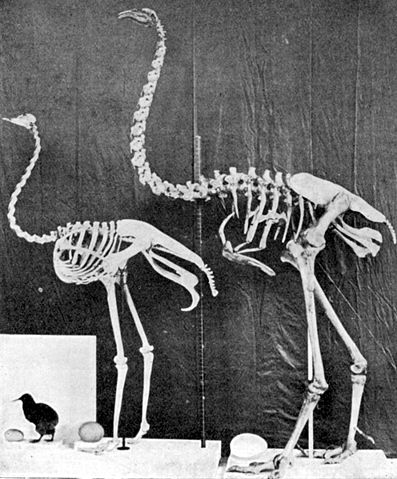
What were the moa and what happened to them? The South Island Giant Moa was a 3.6 m tall bird that were hunted to extinction by 1445.
The Moa were flightless birds that lived in New Zealand. They were very similar to ostriches, but about a meter taller. When they stretched their necks up, the large males were 3.6 m high, but they probably usually kept their necks forward. The males weighed about 230 kg. Ostriches weigh about 150 kg, so moa were considerably larger.
Moa have no wing bones. This is unusual because many birds that have lost the ability to fly still have wings. Ostriches use their wings to balance when they run and to turn quickly. Moa have no wings at all. This leads to the question: how did they get to New Zealand? New Zealand has been isolated from other land masses for over 80 million years, so the theory is that the moa flew to the islands and then lost the ability to fly. Their ancestors might have arrived as long as 60 million years ago. At that time, sea levels were higher and only 18% of modern-day New Zealand was above the sea.
In New Zealand, the Moa had an abundant food source and very few predators, so they had no real need to fly. And, as they slowly grew in size and weight, flight became impossible. The Moa lived on plants. Their beaks were sharp and could cut through plant stems fairly easily. They were grazing animals and they filled the gap in the food chain that llama and antelope fill in other countries. Their beaks were very sharp, and they could easily cut branches and leaves off trees.
The moa were so large that they only had one predator. That was the Haast’s eagle, the largest eagle that has ever lived. It weighed 15 kg and had a huge beak and talons. It wasn’t strong enough to carry a moa, but it could easily kill one and then feed on its carcass. The Haast’s eagle went extinct with the moa because that was their main source of food.
So, what happened to these enormous, magnificent birds? Early theories thought their extinction could be due to climate change, volcanic activity, or a natural decline in their population. Research has disproved all of these theories. DNA taken from 300 moa bodies was analyzed and it showed that there was still genetic diversity. If a population is shrinking, the animals are forced to interbreed and the amount of genetic diversity declines. Genetic illnesses also become common. This happened with the last herd of mammoths. The fact that there is no sign of this with the moa shows that they were a healthy and thriving population.
What could have caused their extinction then? Before 1300, there were no humans on the islands of New Zealand. The islands had been human free for millions of years. Then, in about 1300, the Polynesians used their amazing navigation techniques to find and colonize the New Zealand islands. In the first wave, about 400 people landed. The moa had spent millions of years evolving in a land where they didn’t really have any predators. Within 150 years, by 1445, all of the moa had been hunted to extinction. The Polynesians had hunted them for food. Archaeological excavations of Polynesian settlements have uncovered piles of moa bones from moa of all different ages. The Polynesians ate the old, the young, and the eggs. The species had no chance.
The moa wasn’t the only species that went extinct. The Haast’s eagle died out, along with giant New Zealand geese, and many other birds and mammals.
The problem of over hunting was compounded by the introduction of dogs, cats, and rats. The Polynesians brought animals with them. These animals may have attacked the young moa and eaten their eggs. They were also responsible for the extinction of other smaller animals in New Zealand.
It is very difficult not to judge a people for wiping out a whole species. They had no knowledge and they needed food, so you could say they had no choice. And we are in no position to judge anybody because about 150 species are going extinct every single day during our watch.
So, moa were enormous flightless birds that ate plants and leaves with razor sharp beaks. They probably lived on New Zealand for 60 million years and were hunted to extinction by humans in about 150 years. And that is what I learned today.
Sources
https://en.wikipedia.org/wiki/Moa
https://www.science.org/content/article/why-did-new-zealands-moas-go-extinct
https://en.wikipedia.org/wiki/Haast%27s_eagle
https://teara.govt.nz/en/when-was-new-zealand-first-settled
